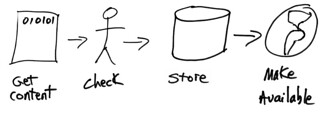
Speaker: Nettie Legace
NISO is more than just the people at the office — it’s the community that comes together to address the problems that we have, and they’re alway soliciting new work items. What are your pain points? Who needs to be involved? How does it relate to existing efforts?
A NISO standard is more formal and goes through a rigorous process to be adopted. A NISO recommended practice is more edgy and discretionary. There are a lot of standards and best practices that have not been adopted, and it depends on the feasibility of implementation.
Get involved if you care about standards and best practices!
Speakers: Jamene Brooks-Kieffer & John Law
They’re talking about the Open Discovery Initiative. Discovery systems have exploded, and there are now opportunities to come together to create some efficiencies through standards. The working group includes librarians, publishers, and discovery service providers.
The project has three main goals: identify stakeholder needs & requirements, create recommendations and tools to streamline process, and provide effective means of assessment. Deliverables include a standard vocabulary, which the group has found they need just to communicate, and a NISO recommended practice. They plan to have the initial draft by January 2013 and finish the final draft by May 2013.
There will be an open teleconference on Monday.
Speaker: Oliver Pesch
SUSHI was one of the first standards initiatives to use the more agile development process which allows for review and revision in 5-7 years. The down side to a fixed standard is that you have to think of every possible outcome in the standard because you may not get a chance to address it again, and with electronic standards, you have to be able to move quickly. So, they focused on the core problem and allowed the standard to evolve through ongoing maintenance.
SUSHI support is now a requirement for COUNTER compliance, and it has been adopted by approximately 40 content providers. MISO client is a free tool you can download and use it to harvest SUSHI reports.
Part of SUSHI’s success comes from being a part of NISO and the integration with COUNTER, but they’re not done. They’re doing a lot of work to promote interoperability, and they have published the SUSHI Server Test Mode recommended practice. They’re also preparing for release 4 of COUNTER, and making adjustments as needed. They’re also publishing a COUNTER SUSHI Implementation Profile to standardize the interpretation of implementation across providers.
Questions/Comments:
Major concern about content providers who also have web-scale discovery solutions that don’t share content with each other — will that ever change? Not in the scope of the work of the ODI. More about how players work together in better ways, not about whether or not content providers participate.
Why is SUSHI not more commonly available? Some really big players aren’t there yet. How fast is this going to happen? A lot of work is in development but not live yet. What drives development is us. [Except we keep asking for it, and nothing happens.] If you allow it to be okay for it to not be there, then it won’t.
JISC created a template letter for member libraries to send to publishers, and that is making a difference.

